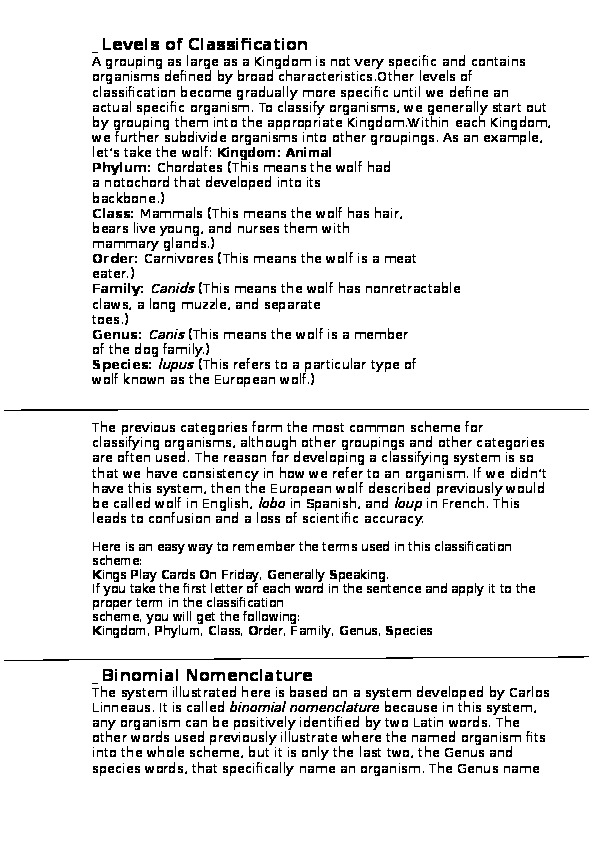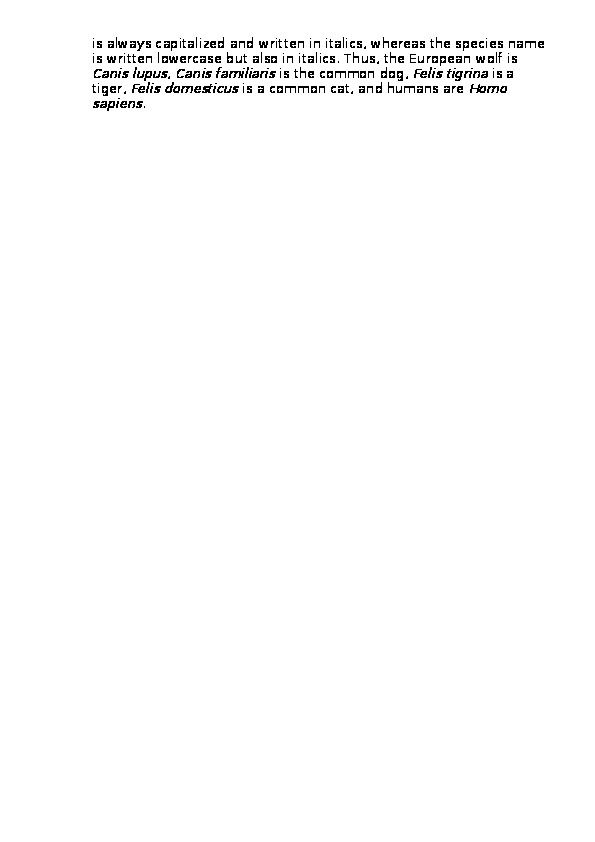Levels of Classification
A grouping as large as a Kingdom is not very specific and contains organisms defined by broad characteristics.Other levels of classification become gradually more specific until we define an actual specific organism. To classify organisms, we generally start out by grouping them into the appropriate Kingdom.Within each Kingdom, we further subdivide organisms into other groupings. As an example, let’s take the wolf: Kingdom: Animal
Phylum: Chordates (This means the wolf had
a notochord that developed into its
backbone.)
Class: Mammals (This means the wolf has hair,
bears live young, and nurses them with
mammary glands.)
Order: Carnivores (This means the wolf is a meat
eater.)
Family: Canids (This means the wolf has nonretractable
claws, a long muzzle, and separate
toes.)
Genus: Canis (This means the wolf is a member
of the dog family.)
Species: lupus (This refers to a particular type of
wolf known as the European wolf.)Levels of Classification
_ Levels of Classification
A grouping as large as a Kingdom is not very specific and contains
organisms defined by broad characteristics.Other levels of
classification become gradually more specific until we define an
actual specific organism. To classify organisms, we generally start out
by grouping them into the appropriate Kingdom.Within each Kingdom,
we further subdivide organisms into other groupings. As an example,
let’s take the wolf: Kingdom: Animal
Phylum: Chordates (This means the wolf had
a notochord that developed into its
backbone.)
Class: Mammals (This means the wolf has hair,
bears live young, and nurses them with
mammary glands.)
Order: Carnivores (This means the wolf is a meat
eater.)
Family: Canids (This means the wolf has nonretractable
claws, a long muzzle, and separate
toes.)
Genus: Canis (This means the wolf is a member
of the dog family.)
Species: lupus (This refers to a particular type of
wolf known as the European wolf.)
The previous categories form the most common scheme for
classifying organisms, although other groupings and other categories
are often used. The reason for developing a classifying system is so
that we have consistency in how we refer to an organism. If we didn’t
have this system, then the European wolf described previously would
be called wolf in English, lobo in Spanish, and loup in French. This
leads to confusion and a loss of scientific accuracy.
Here is an easy way to remember the terms used in this classification
scheme:
Kings Play Cards On Friday, Generally Speaking.
If you take the first letter of each word in the sentence and apply it to the
proper term in the classification
scheme, you will get the following:
Kingdom, Phylum, Class, Order, Family, Genus, Species
_ Binomial Nomenclature
The system illustrated here is based on a system developed by Carlos
Linneaus. It is called binomial nomenclature because in this system,
any organism can be positively identified by two Latin words. The
other words used previously illustrate where the named organism fits
into the whole scheme, but it is only the last two, the Genus and
species words, that specifically name an organism. The Genus nameis always capitalized and written in italics, whereas the species name
is written lowercase but also in italics. Thus, the European wolf is
Canis lupus, Canis familiaris is the common dog, Felis tigrina is a
tiger, Felis domesticus is a common cat, and humans are Homo
sapiens.
How to Scheme


